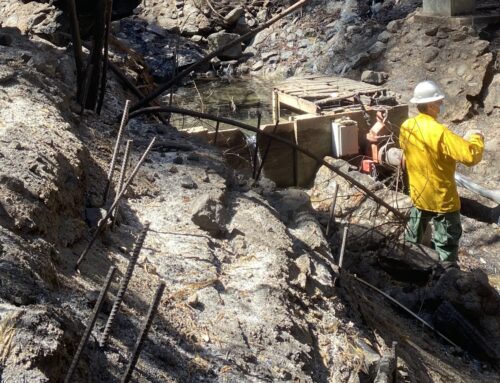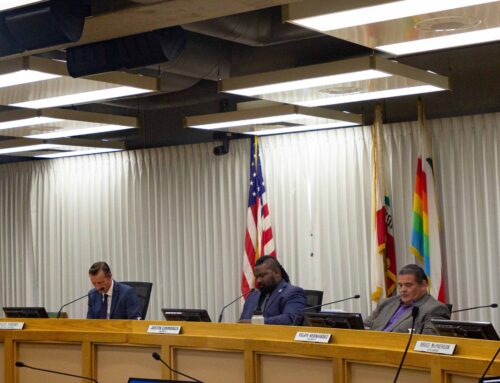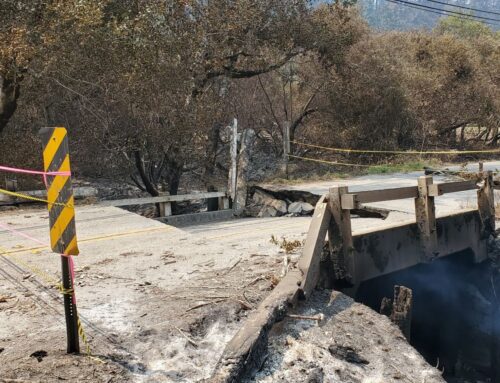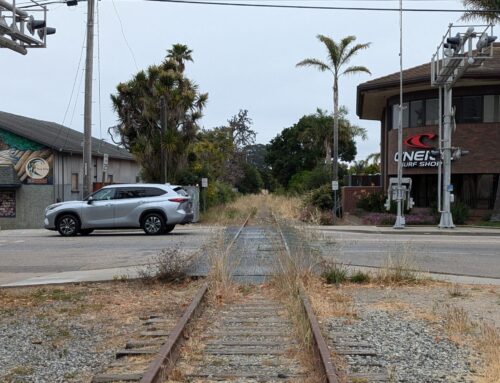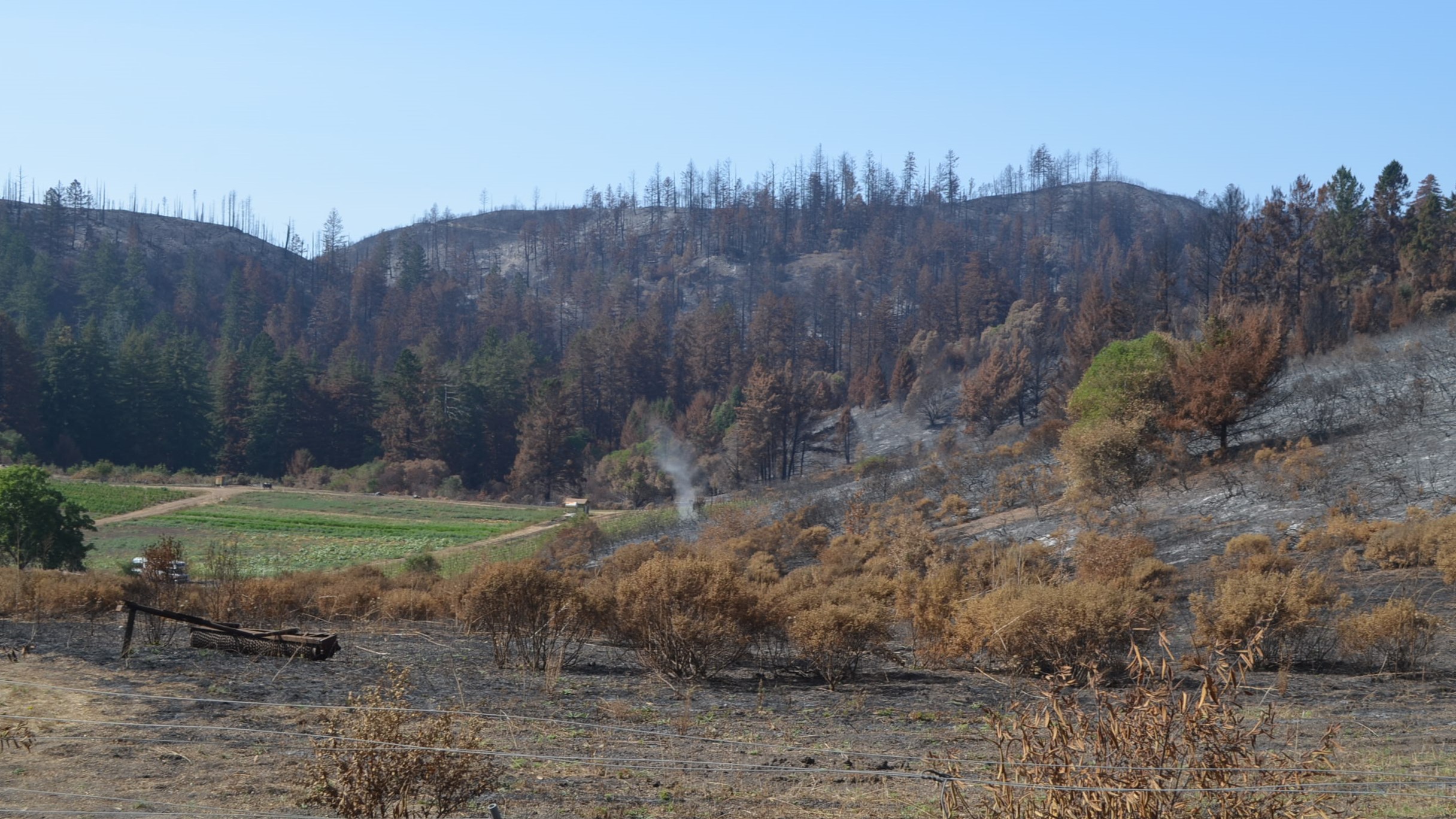
Santa Cruz County voters on Nov. 5 will consider a parcel tax for county, city and nonprofit projects to help reduce the risks of wildfires, floods and other catastrophes fueled by climate change. Charred hills are shown near Davenport after the CZU Lightning Complex Fire in 2020. (Stephen Baxter — Santa Cruz Local file)
Key takeaways
- A proposed $87 parcel tax on the Nov. 5 ballot would raise $7.5 million annually for projects on public and private land that reduce the risks of wildfires and floods, conserve water and otherwise manage open space in Santa Cruz County.
- Projects could include brush clearing, prescribed burns, cleanups, new trails and water conservation projects.
- The money would go to the county, cities, nonprofits and other public agencies.
- At least one San Lorenzo Valley fire chief pushed back on the measure in part because it does not directly fund fire department projects to reduce fire risks.
SANTA CRUZ >> To help reduce risks of wildfires, floods and other catastrophes fueled by climate change, Santa Cruz County voters on Nov. 5 will consider an $87 annual parcel tax that would fund land and water management, cleanup and conservation.
The Water and Wildfire Protection Act would raise about $7.5 million annually for projects in forests, streams, beaches and other open spaces. At least one San Lorenzo Valley fire chief pushed back on the measure, saying it should directly fund fire department projects to reduce wildfire risk.
“As our climate is changing and bringing along with it more frequent and intense droughts, more powerful storm events, as well as more frequent and catastrophic wildfires, we need to do more to protect and manage our land base,” said Sarah Newkirk, executive director of the nonprofit Land Trust of Santa Cruz County.
A group called Santa Cruz County Residents for Clean Water, Fire Safety and Climate Resilience collected more than 10,000 signatures needed to place the measure on the ballot. Newkirk’s organization, along with nonprofits Peninsula Open Space Trust and Sempervirens Fund are the measure’s top campaign funders, according to the ballot measure supporters’ website.
The measure requires more than 50% of the vote to pass. The tax would last indefinitely unless ended by voters.
What would the tax fund?
The money could go to many types of land cleanup, management, recreation and restoration projects, including:
- Prescribed burns and fuel removal in forests.
- Removing brush around homes to create defensible space.
- New public trails.
- Wetland restoration.
- Wildlife road crossings.
- Water conservation and groundwater recharge.
- Trash removal on public lands or beaches.
Some of these projects can have direct impacts on the intensity of natural disasters like floods and fires, Newkirk said.
For example, a “shaded fuel break,” or strip of land cleared of underbrush, reduced fire damage in the San Vicente Redwoods during the 2020 CZU Lightning Complex Fire. Creating more shaded fuel breaks could make the next fire less disastrous, Newkirk said. Similarly, restored floodplains on the Pajaro River could reduce catastrophic flooding downstream, she said. The Pajaro River levee breached during storms in March 2023 and flooded dozens of homes, displacing about 3,000 people.
Who would receive the money?
The tax would raise an estimated $7.5 million annually for projects that manage open space, protect water sources and reduce fire risk in Santa Cruz County.
About $3 million annually — 40% of the money — would fund county-administered grants to nonprofits or public agencies. The grant program would favor projects that support resilience to climate change, have matching funds or serve disadvantaged communities.
At least $600,000 of the grant money would go towards “the property protected by the largest conservation easement in the county,” according to the ballot measure. That property is San Vicente Redwoods, an 8,900-acre privately owned forest managed by the Land Trust of Santa Cruz County, Peninsula Open Land Trust, the Sempervirens Fund and Save the Redwoods League. Trails on the property opened to the public in 2022.
At least another $600,000 of the grant money would fund projects near South County rivers, streams and wetlands.
The measure would also allocate:
- 20% to the Resource Conservation District of Santa Cruz County and a nonprofit partner selected by an oversight board for projects on privately owned land. The partner must be a Santa Cruz County-based nonprofit that has operated for at least 10 years and owns and manages private open space. The Land Trust of Santa Cruz County meets those criteria, but Newkirk said she’s unsure if any other nonprofits do.
- 20% of funds, about $1.5 million annually, to cities within Santa Cruz County, split proportionally by population.
- 20% to the county Department of Parks, Open Space, and Cultural Services and the county Office of Response, Recovery and Resilience for projects outside of cities.
Who would oversee spending?
A nine-person citizen oversight advisory board would:
- Create a five-year plan for spending.
- Hold public meetings to receive public input on spending.
- Receive spending reports from the county, the cities and the Resource Conservation District.
- Select the nonprofit partner to receive direct funding. The measure does not prohibit nonprofit employees from sitting on the advisory board.
The board would include one appointee from each of the five county districts and the four cities. Members cannot be elected officials, and must have expertise in a relevant field, such as natural resources, wildlife, or environmental justice.
Who supports the measure?
The Fire Safe Council of Santa Cruz County, Regeneración – Pajaro Valley Climate Action, and other environmental nonprofits have endorsed the measure.
The Santa Cruz County Board of Supervisors, the Santa Cruz City Council, and the Capitola City Council have also voted to endorse the proposed tax.
“This plan really does have a lot to offer, and I think it’s going to bolster our natural resources,” said Santa Cruz County Supervisor Bruce McPherson, at a June 4 county supervisors meeting.
What have opponents said?
Aside from the $600,000 earmarked for San Vicente Redwoods, none of the money is required to be spent on fire risk reduction efforts. That doesn’t sit well with Zayante Fire Chief Jeff Maxwell.
“I just think that they need to cut a third of the name off of the measure,” he said. “Rename it the land and water protection” act, Maxwell said. Maxwell said he was speaking as a citizen, not on behalf of Zayante Fire.
Newkirk said some detractors have said the measure would compete with bond measures to support fire departments. All of those measures should be supported, she said.
“There are at least two important features in fire safety: one is fire response, and that’s what the fire departments do really well,” said Newkirk. “The other is fire resilience, and that really is keeping the fuel loads down and fire risk low in the surrounding environment. And that’s work that can be done using funds under this measure. I don’t think that it should be competitive at all, because we need both response and resilience.”
Maxwell said fire departments can helm the fire resilience projects, but they aren’t guaranteed money to do so.
“The fire districts in the San Lorenzo Valley that were confronted with the CZU [Lightning Complex Fire] get $0 for any type of fuel reduction,” Maxwell said.
Fire districts could apply for grant money for fire risk reduction projects, but Maxwell said his department is too small to dedicate time to grant writing.
Alison Breeze, a San Lorenzo Valley resident and leader of a neighborhood Firewise wildfire preparedness group, said she was concerned groups like hers wouldn’t be able to find nonprofits to partner with them, and wouldn’t receive any grant funding.
“I love the goals that this [measure] has, but I have concerns about whether it can practically achieve what it’s promising,” she said.
Learn more
More from Santa Cruz Local
- Improved access planned for Santa Cruz County’s North Coast — Jan. 12, 2024
- Agencies aim to increase controlled burns in Santa Cruz County — May 18, 2023
- San Vicente Redwoods trails to open Dec. 3 — Nov. 10, 2022
- Summit, Soquel residents band together to manage forests — June 24, 2022
Questions or comments? Email [email protected]. Santa Cruz Local is supported by members, major donors, sponsors and grants for the general support of our newsroom. Our news judgments are made independently and not on the basis of donor support. Learn more about Santa Cruz Local and how we are funded.
Jesse Kathan is a staff reporter for Santa Cruz Local through the California Local News Fellowship. They hold a master's degree in science communications from UC Santa Cruz.


